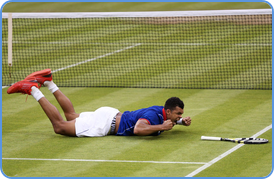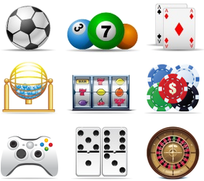 |
Beginners Guide to Tennis Betting |
Tennis is a game which originates from the 12th century, and comes from both French and English backgrounds.
In the very beginning, people used their palms to hit balls in the game of tennis, and it wasn't until more recent in the 16th century where people started to use rackets to play the sport.
In that times, the game started to become populated in England and got it's official name of ‘Tennis‘.
In the very beginning, people used their palms to hit balls in the game of tennis, and it wasn't until more recent in the 16th century where people started to use rackets to play the sport.
In that times, the game started to become populated in England and got it's official name of ‘Tennis‘.
 |
In 1926 the game of tennis finally found some professional grounding, with players such as Suzanne Lenglen taking up the sport and founding its routes.
In 1968 tennis became a much loved sport around the world, with a professional circuit for both women's and men's tennis being established, with tournaments being played on an international level just like present day. On the left picture: The postage stamp from Austria, feature famous tennis player Roger Federer. |
Basic Rules of Tennis
Points
Before a tennis player can win a game, they must first win points. In a typical tennis game the person who wins the first 4 points wins, and is usually constructed as the following: 15 (point 1), 30 (point 2), 40 (point 3), game (point 4).
Let us show you an example,
if Player 1 was winning a game 40-15, they would be on 3 points and the opponent would be on 1 point. If Player 1 wins their next point they will win the game.
If both players have 3 points it’s known as deuce. (40-40). In this scenario the person serving must win the next two points consecutively to win the game. If they win their next point at deuce they win a point called ‘Advantage’ (Ad-40). If they, then win the following point they will win the game, but if their opponent wins the point, the game will go back to ‘Deuce’ (40-40) and the process is repeated until someone wins the game.
Before a tennis player can win a game, they must first win points. In a typical tennis game the person who wins the first 4 points wins, and is usually constructed as the following: 15 (point 1), 30 (point 2), 40 (point 3), game (point 4).
Let us show you an example,
if Player 1 was winning a game 40-15, they would be on 3 points and the opponent would be on 1 point. If Player 1 wins their next point they will win the game.
If both players have 3 points it’s known as deuce. (40-40). In this scenario the person serving must win the next two points consecutively to win the game. If they win their next point at deuce they win a point called ‘Advantage’ (Ad-40). If they, then win the following point they will win the game, but if their opponent wins the point, the game will go back to ‘Deuce’ (40-40) and the process is repeated until someone wins the game.
Games
 |
After winning a game, the score is updated and the score will read as being 1-0 to whoever won the game.
After the initial server has won her/his game, it's now the opponents turn to serve and they will attempt to win a game as well. If they go on to win a game themselves, the score will then read 1-1. On the left picture: Great player Christina Mchale is fighting to win game at WTA Rome. |
This process is repeated until either player wins 6 games with a break in-between leading them to win the set, (except for the instance of a tie-break, or longer match see more below).
To win a game in between, is called having the ‘break’, and is where your opponent has failed to ‘hold’ serve and failed to win one of their games when they have been serving.
To win a game in between, is called having the ‘break’, and is where your opponent has failed to ‘hold’ serve and failed to win one of their games when they have been serving.
If Player 1 and Player 2 are each on 1-1 (one game each), and Player 2 doesn’t win their own game when serving, Player 1 will win the game, and will have the ‘break’.
The scoreboard would now read 2-1 to Player 1. If Player 1 ‘holds the break’ the score will then read 3-1. Holding the break is an important aspect of tennis, and by breaking your opponent you have a much quicker chance at winning the match.
The scoreboard would now read 2-1 to Player 1. If Player 1 ‘holds the break’ the score will then read 3-1. Holding the break is an important aspect of tennis, and by breaking your opponent you have a much quicker chance at winning the match.
In this scenario, all Player 1 needs to do is hold his own serve to win the set, and not lose any of his own service games. If Player 1 reaches 6 games with a break in between, he/she then wins the set. This scoreline could be anything from 6-0,6-1,6-2,6-3 or 6-4.
If there is no break till the later stages of the match, the scoreline may read 7-5. 7-5 is where neither player have failed to break their opponents till the later stages of the match, and is usually where both players have held serve up until 5-5.
If there is no break till the later stages of the match, the scoreline may read 7-5. 7-5 is where neither player have failed to break their opponents till the later stages of the match, and is usually where both players have held serve up until 5-5.
Tie-Break
 |
A tie-break occurs when neither player has broken their opponent and held serve to win the set. A tie-break is essentially a scenario in which the game level is at 6-6, and both players are playing a high-level.
A tie-break takes place where each player takes it in turns each serving to win points, but instead of the points being called 15,30,40, etc. they are simply numbers 1,2,3, etc. The first person to reach 7 points wins the first set, providing one of the players wins one of their opponent’s points. On the left picture: Kaia Kanepi playing high. Her face supposedly saying: I'm going to win this set! |
Example: Player 1 and Player 2 are both level in the tie-break at 3-3. However, Player 2 wins Player 1's point on his serve and goes a break up in points 3-4, Player 2 then continues to win his service points and wins the set 7-6 on games.
Some tie-breaks don’t always end with the player just reaching 7 points however, and if neither player breaks their opponent till the later stages of the tie-break, the tie-break can sometimes finish 10-8,14-12, or higher.
Please note that it's always best to check the tie-break rule, as it could be different in various tournaments, if you're planning on betting.
Please note that it's always best to check the tie-break rule, as it could be different in various tournaments, if you're planning on betting.
Sets
Once a player has won a series of games and beat their opponent for example 6-4, they now have won a set. In most tournaments three sets in total are played, and the person who wins the most sets wins the match.
A person who is a strong player will usually win in straight sets, this is indicated by winning 2 sets off your opponent, and a third doesn't have to be played. However, if both players have won a set each, a third and final deciding set is played.
A person who is a strong player will usually win in straight sets, this is indicated by winning 2 sets off your opponent, and a third doesn't have to be played. However, if both players have won a set each, a third and final deciding set is played.
Types of tennis bets
Betting on tennis offers many opportunities to make money, with a variety of different kinds of bets available. All major bookmakers offer betting on tennis, including women’s and men’s tennis events daily throughout the year. Below are some of the basic betting markets which can be used to bet on.
Outright match winner
Betting on the outright match winner is simply choosing who you expect to win the match.
1st set/2nd set winner, etc.
Some bookmakers offer the ability to bet on which player you think will win each set. You can choose which player you believe will win the first, second or third and final set.
Asian Handicap (game betting)
|
On the right picture: Tennis player show his joy of winning.
Handicap betting is where you’re either giving a player a head start in the match by betting on them having for example a 4.5 game lead prior to the match even starting, or if you think a player is going to be very strong, a 4.5 game loss. For example. A bookmaker may be offering +4.5 games on the handicap for Player 1 against Player 2. Player 1 is the underdog coming into the match, and isn’t the likely winner.
|
 |
However, with the handicap you have bet on at +4.5 games, you’re essentially getting 4.5 games in addition to the players games they do win in the match.
If Player 1 loses the match 7-5,6-4, your handicap bet of +4.5 games wins. How does this work? You simply add 4.5 [PLUS] the number of games the player did win, which in this case would be 5 games in the first set, and 4 games in the second, resulting in 13.5. This means that Player 2 has only 13 games (7 + 6).
If Player 1 loses the match 7-5,6-4, your handicap bet of +4.5 games wins. How does this work? You simply add 4.5 [PLUS] the number of games the player did win, which in this case would be 5 games in the first set, and 4 games in the second, resulting in 13.5. This means that Player 2 has only 13 games (7 + 6).
This can also work the other way around as well. With minus on the handicap, subtracting games from a player prior to the match beginning, and is usually used on very strong favourites.
Set betting
Set betting is where you can choose whether you think a player will win or lose in straight sets, or in multiple sets. A common bet is to bet on strong favourites to win a match in straight sets at bigger odds. However, if the player doesn't win in straight sets, your bet will lose.
Total number of games betting
This is a bet where you choose how many games you think there is going to be in the match. This can range from 19.5,20.5 or higher depending on the match in question.
For example, if you bet on a match having Over 21.5 games in it, and the result of the match is 7-6,6-3, your bet would win because there are 22 games played in the match.
For example, if you bet on a match having Over 21.5 games in it, and the result of the match is 7-6,6-3, your bet would win because there are 22 games played in the match.
Major tennis events
The major events known in tennis game are called Grand Slams, also called Majors. Grand Slam events are the biggest tennis events annually, and attract the most betting activity in the world of tennis.
 |
Grand Slam events are spread out through each year, with the Australian Open; the first major tournament taking place at the beginning of the year in January.
Roland Garros, also known as the French Open is played in France each year in May, and is followed by the world's most famous Grand Slam event; Wimbledon. Wimbledon is played in June each season and is the only Grand Slam event to be played on grass. The final Grand Slam event of the year is the US Open. The US Open; played in the United States usually attracts large amounts of bettors from North America, and the US Open is considered one of the biggest Grand Slams alongside Wimbledon. On the left picture: Rolex Masters Tennis Tournament in Monte Carlo, Monaco in 2013 on postage stamp. We love to collect sport theme stamps. |
Betting strategies
Total number of games betting
One thing you should always try and to do before betting on a tennis match is to make sure you only back players who you know are fit and ready for the tournament. The best way to find this kind of information out is to simply look at where they played in their last tournament.
If a player is taking part in a tournament today in China, yet just finished a tournament 24 hours ago in Europe, the chances are the player may well be tired, and not fit enough to play this match.
Due to tennis being an international sport, jet lag can play an important factor in tennis, and should not be overlooked.
Due to tennis being an international sport, jet lag can play an important factor in tennis, and should not be overlooked.
It's recommended in this instance to always try and to avoid betting on this type of match, or (if your analysis from other research allows it) back the other player instead.
Backing the person who wins the second set
Statistically, around 50% of the time the person who wins the second set in a 3 three set match usually goes on to win the match.
If Player 1 is playing against Player 2, and the current score is 6-1,3-6, it now means that another third and final set has to be played. It's in these types of circumstances where 50% of the time the player who has won the second set goes on to later win the match. If Player 2 has won the second set 3-6, it's most likely that he or she will go on to win the third set as well.
It's also important to notice whether the player who has won the second set is the first person to serve in the third set. If the person who won the second set does in fact serve in the third set, this fact increases the likelihood that they will win the match.
The logic and phycology behind this is quite clear, and it all falls in the theory of momentum.
The player who has won the second set will generally feel quite upbeat and quite happy, and as they go into the third set they will most likely carry this positive tone along with them.
Their momentum, adrenaline and positive attitude will also be increased if he/she is the first person to serve in the third set as well. The person who lost the second set most of the time will be tired, mentally drained and in a more negative mood, hence less reason to back that player to win the match.
The player who has won the second set will generally feel quite upbeat and quite happy, and as they go into the third set they will most likely carry this positive tone along with them.
Their momentum, adrenaline and positive attitude will also be increased if he/she is the first person to serve in the third set as well. The person who lost the second set most of the time will be tired, mentally drained and in a more negative mood, hence less reason to back that player to win the match.
In this strategy you need to take into account each match individually, and decide whether you think betting on the outcome is worth it or not in comparison to the odds offered by your bookmaker.
If you are interested to learn more, we encourage you to read our another educative page:
Advanced Tennis Betting Techniques. Enjoy!
Advanced Tennis Betting Techniques. Enjoy!
The Best Game Of Tennis Ever?
In tennis you can go for games without seeing something truly outstanding. When Andy Murray took on Michael Llodra they produced four of the best points you will ever see in the course of a single game.
Video courtesy of Australian Open TV.
Video courtesy of Australian Open TV.






